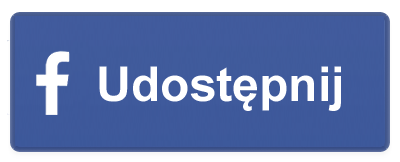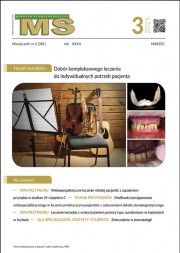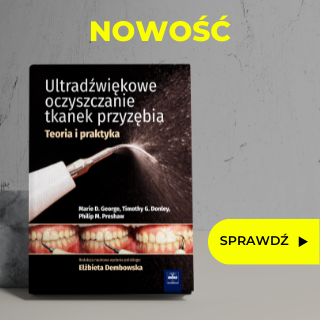Dostęp do tego artykułu jest płatny.
Zapraszamy do zakupu!
Po dokonaniu zakupu artykuł w postaci pliku PDF prześlemy bezpośrednio pod twój adres e-mail.
Artur Matthews-Brzozowski i Maja Matthews-Kozanecka
PIŚMIENNICTWO
1. Swennen G.R.J. i wsp.: A Cone-Beam Computed Tomography triple scan procedure to obtain a three-dimensional augmented. Virtual skull model appropriate for orthognathic surgery planning. J. Craniofac. Surg., 2009, 20, 297-307.
2. Scarfe W.C., Farman A.G., Sukovic P.: Clinical applications of cone-beam computed tomography in dental practice. J. Can. Dent. Assoc., 2006, 72, 1, 75-80.
3. Ludlow J.B., Ivanovic M.: Comparative dosimetry of dental CBCT devices and 64-slice CT for oral and maxillofacial radiology. Oral Surg. Oral Med. Oral Pathol. Oral Radiol. Endod,. 2008, 106, 1, 106-114.
4. Chhabra S., Yadav S., Talwar S.: Analysis of C-shaped canal systems in mandibular second molars using surgical operating microscope and cone beam computed tomography: A clinical approach. J. Conserv. Dent., 2014, 17, 3, 238-243.
5. Różyło-Kalinowska I.: Standardy Europejskiej Akademii Radiologii Stomatologicznej i Szczękowo-Twarzowej dotyczące obrazowania wolumetrycznego (CBCT). Mag. Stomatol., 2009, XIX, 5, 12-16.
6. Lorenzoni D.C. i wsp.: Cone-Beam Computed Tomography and radiographs in dentistry: aspects related to radiation dose. Int. J. Dent., 2012, 2012, 813768, doi: 10.1155/2012/813768. Epub 2012 Apr 4.
7. Owecka M., Dyszkiewicz-Konwińska M., Kulczyk T.: Zastosowanie tomografii komputerowej z promieniem stożkowym (CBCT) w stomatologii i laryngologii. Nowiny Lek., 2012, 81, 6, 653-657.
8. Renton T. i wsp.: A randomised controlled clinical trial to compare the incidence of injury to the inferior alveolar nerve as a result of coronectomy and removal of mandibular third molars. Br. J. Oral Maxillofac. Surg., 2005, 43, 7-12
9. Miracle A.C., Mukherji S.K.: Conebeam CT of the head and neck, part 2: clinical applications. Am. J. Neuroradiol., 2009, 30, 7, 1285-1292.
10. Swennen G.R.J., Mollemans W., Schutyser F.: Three-dimensional treatment planning of orthognathic surgery in the era of virtual imaging. J. Oral Maxillofac. Surg., 2009, 67, 2080-2092.
11. Oosterkamp B.C.M., Damstra J., Jansma J.: Asymmetrie van het aangezicht: de meerwaarde van cone beam-computertomografie. Ned Tijdschr Tandheelkd. 2010, 117, 269-273 [in Dutch].
12. Alshehri M.A., Alamri H.M., Alshalhoob M.A.: Zastosowanie CBCT w praktyce stomatologicznej – systematyczny przegląd piśmiennictwa. Dental Tribune., 2012, 9, 1-5.
13. Edwards R. i wsp.: The frequency and nature of incidental findings in large-field cone beam computed tomography scans of an orthodontic sample. Progress in Orthodontics , 2014, 15, 37.
14. Long H. i wsp.: Coronectomy vs. total removal for third molar extraction: a systematic review. J. Dent. Res., 2012, 91, 7, 659-665.
15. Dula K. i wsp.: SADMFR Guidelines for the Use of Cone-Beam Computed Tomography/Digital Volume Tomography. Swiss Dental Journal SSO, 2014, 124, 1170-1183.
16. Smith-Bindman R. i wsp.: Radiation dose associated with common computed tomography examinations and the associated lifetime attributable risk of cancer. Arch Intern Med., 2009, 169, 22, 2078-2086.
17. Czechowska E. i wsp.: Komplikacje podczas zabiegu operacyjnego usuwania zęba mądrości – opis przypadku. Dental Forum, 2013, 1, 41, 119-122.
18. Mahon N., Stassen L.F.: Post-extraction inferior alveolar nerve neurosensory disturbances-a guide to their evaluation and practical management. J. Ir. Dent. Assoc., 2014, 60, 5, 241-250.
19. Guerrero M.E. i wsp.: Can preoperative imaging help to predict postoperative outcome after wisdom tooth removal? A randomized controlled trial using panoramic radiography versus cone-beam CT. Clin. Oral Investig., 2014, 18, 1, 335-342.
20. Matzen L.H. i wsp.: Audit of a 5-year radiographic protocol for assessment of mandibular third molars before surgical intervention. Dentomaxillofac. Radiol., 2014, 43, 8, 20140172. doi: 10.1259/dmfr. 20140172.
21. Renton T.: Update on coronectomy. A safer way to remove high risk mandibular third molars. Dent. Update, 2013, 40, 5, 362-364, 366-368.
22. Ma Z. i wsp.: Efficacy of the technique of piezoelectric corticotomy for orthodontic traction of impacted mandibular third molars. Br. J. Oral Maxillofac. Surg., 2015, 28. pii: S0266-4356(15)00003-0. doi:10.1016/j.bjoms.2015.01.002.
23. de Jongh A. i wsp.: Anxiety and post-traumatic stress symptoms following wisdom tooth removal. Behav. Res. Ther., 2008, 46, 1305-1310.
24. de Jongh A., van Wijk A.J., Lindeboom J.A.: Psychological impact of third molar surgery: A 1-month prospective study. J. Oral Maxillofac. Surg., 2011, 69, 59-65.
25. Matthews-Kozanecka M., de Mezer M.: Eksperyment medyczny w leczeniu ortodontycznym. TPS, Twój Przegl. Stomatol., 2011, 4, 39-44.
26. Czarkowski M., Różyńska J.: Świadoma zgoda na udział w eksperymencie medycznym. Poradnik dla badacza. Wyd. NIL, Warszawa 2008.
27. Ferrús-Torres E. i wsp.: Informed consent in oral surgery: the value of written information. J. Oral Maxillofac. Surg., 2011, 69, 54-58.
28. Matthews-Kozanecka M., Głowacka A: Świadoma zgoda pacjenta na udział w badaniach klinicznych i planowanym leczeniu –aspekty etyczno-prawne. Now. Lek., 2010, 79, 4, 330-333.
29. Sitarska-Haber A., Jędrzejowski A.: Świadoma zgoda uczestnika na udział w badaniu klinicznym – co badacz wiedzieć powinien. Standardy Medyczne/Pediatria,2012, 9, 233-241.
30. Bączyk-Rozwadowska K.: Prawo pacjenta do informacji według przepisów polskiego prawa medycznego. Studia Iurdica Toruniencia, 2011, 9, 60-100.














